Socializing, scholarship come together in Experimental Study Group
Read this at MIT Spectrum
Maya Redden ’23 arrived in Cambridge, Massachusetts, from a small town in Idaho. She wanted a smooth transition to college, especially one as large and rigorous as MIT.
She enrolled in the Experimental Study Group (ESG) on the advice of a friend who hailed the tight-knit ESG community and its small classes as an antidote to vast lectures. ESG, which marks its 50th anniversary this year, is a first-year program that combines community-building activities, such as weekend trips and themed Friday luncheons, with core academics. Enrollment is capped at 55 students each year.
“Most ESG classes have 12 students or fewer. It’s really nice having that small class where you can take the time to stop and ask questions,” Redden says, noting that the format fosters discussion, even in hard science classes.
Launched in 1969, the concept was revolutionary for MIT at the time, when many undergraduate requirements were taught in large lecture halls with as many as 500 students and one professor. ESG was founded by physicist George Valley Jr., Class of 1935, who created the Semi-Automatic Ground Environment air defense system, the impetus for MIT’s Lincoln Laboratory. Valley wanted to bring small group learning to MIT’s technical education.
“He was deeply concerned about the people MIT was not serving well,” says ESG associate director Graham Ramsay. “We try to tear the curtain down between the siloed approach to education and social life, so that there’s a sense that people commune together in very different ways. You walk by a classroom, and there’s an awful lot of laughter, and people are very social and very much engaged.”
ESG director Leigh Royden PhD ’82, professor of geology and geophysics, identifies the cornerstones of ESG that have survived for 50 years. “ESG was founded on the principles of encouraging students to identify their academic passions, take responsibility for their own education to pursue those passions, peer teaching and learning, and community.”
ESG has a dedicated suite that serves as a supportive village on an expansive campus, says program alumna Lydia Light ’21.
“Every Friday, a few students cook for everybody. It’s a supportive family. I know that ESG is a place that I can go to and feel at home,” she says—to eat, meet friends, or chat with professors who thrive on personal contact with students.
“ESG is a celebration of diversity and experimentation, and I think that both diversity and experimentation are fundamental for the progress of community and humanity in general. Even though we’re just a small group of people, I feel that we can make a difference,” says physics lecturer Paola Rebusco.
And they do: James Rising ’03 calls his ESG experience “transformative.”
“MIT is a place where you’re held to a very high standard. There are a lot of really smart people that, in other circumstances, you might feel in competition with,” he says. “Instead, at ESG, we’re all one big community helping each other.”
Rising went on to become a research professor of climate economics at the London School of Economics. He says he was motivated by the experimental approach of Peter Dourmashkin ’76, ’78, PhD ’84, an MIT senior lecturer in physics who “cared so much about helping us to understand deeply how physics worked, how to approach a problem, how to understand the essential elements of any question.”
Students liked Dourmashkin so much, in fact, that they requested an extra seminar with him, and he said yes. “That’s the kind of thing that happens at [ESG]. Now, as a professor, I’m drawing on those ideas of innovative project-based learning and helping students be in charge of their education,” Rising says.
At ESG, students say, pushing boundaries, asking questions, and engaging deeply with the curriculum on a personal level lays the groundwork for the rest of their academic careers.
“The best decision that I made my freshman year was joining ESG. It had that big of an impact on my life here. I cannot recommend it more,” Light says.
Story Image: Left: Experimental Study Group students Rich Hilliard, Harry Bochner, and Henry Lieberman work together in 1972. Right: Professor Leigh Royden, center, teaches physics to first-years (from left, Alexandra Nwigwe, Veronica Perdomo, and Maya Redden) in 2019. Photos: Courtesy of Experimental Study Group



